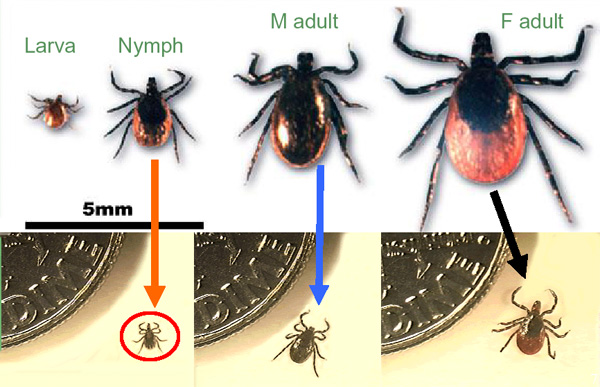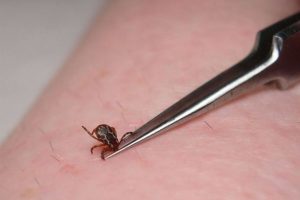Below are a few important tips for preventing tick bites. This information has been compiled from discussions with Lyme experts and information from the CDC, the CT Agricultural Experiment Station and the Housatonic Valley Council of Elected Officials websites. Tick pictures courtesy of the Housatonic Valley Council of Elected Officials.
The first step in preventing tick bites is to know what ticks look like and how small they really are.

Keep ticks off of you:
- There are a variety of tick repellants that you can spray on yourself to help repel ticks (as well as other biting insects). Sprays that contain DEET are commonly recommended. We’re not big fans; spray some DEET on a plastic bandaid and you’ll see why. We have tried many herbal sprays over the years with varied results. Our current favorite is Tick Shield from Cedarcide. It works great and we feel comfortable spraying on our entire family, including our young daughter and our dogs.
- Permethrin is a type of repellent; it can kill ticks. It can be purchased at outdoor equipment stores that carry camping or hunting gear. One application to pants, socks, and shoes typically stays effective through several washings. Permethrin should not be applied directly to skin.
- Wear long pants, long sleeves, and long socks to keep ticks off your skin. Light-colored clothing will help you spot ticks more easily. Tucking pant legs into socks or boots and tucking shirts into pants help keep ticks on the outside of clothing. If you’ll be outside for an extended period of time, tape the area where your pants and socks meet to prevent ticks from crawling under your clothes.
Tick checks are key!
Check your body for ticks after being outdoors, especially in your own yard. Conduct a body check whenever you come in from the outdoors. Search your entire body for ticks. Using a mirror will help you see those hard to see areas. Remove any tick you find. Pay extra attention to these body areas:
- Under the arms
- In and around the ears
- Inside belly button
- Back of the knees
- Under the arms
- In the hair
- Between the legs (in the groin area)
- Around the waist
Tick checks should be performed daily all year round in Connecticut. As Connecticut’s peak tick season is early Spring through mid-Fall, tick checks after any outdoor activity are essential.
Important tick check reminders:
Check your clothing for ticks
Check your children for ticks
Check your pets for ticks.
Tick removal:
Remove a tick from your skin as soon as you notice it. Use fine-tipped tweezers to firmly grasp the tick very close to your skin. With a steady motion, pull the tick’s body away from your skin. Gently maintain this upward traction until the tick release it’s grip on your skin. This may take 30-60 or more seconds. Be patient. Avoid yanking the tick out quickly as this increases the risk of having the tick mouth parts left in your skin. Then clean your skin with soap and warm water.

Fine-tipped tweezers can often be found in the beauty section of your local pharmacy. You may like the magnifier on ProTickMe tweezers.
Avoid crushing the tick’s body. Do not be alarmed if the tick’s mouthparts remain in the skin. Once the mouthparts are removed from the rest of the tick, it is believed it can no longer transmit the Lyme disease bacteria. If you accidentally crush the tick, clean your skin with soap and warm water or alcohol.
Don’t use petroleum jelly, a hot match or any other products to remove a tick. This will only increase the likelihood of transmission of Lyme disease and/or a co-infection.
What should I do if I’m bit by a tick?
Remove the tick as recommended. Contact a healthcare provider who knows about Lyme disease immediately. You can get Lyme disease or a co-infection from any tick that is attached, no matter how long. Improperly removing the tick only increases the risk of disease transmission. In other words, you should be evaluated by a healthcare provider after ANY tick bite, no matter how long the tick was attached.
Create a tick-safe zone.
Use landscaping techniques to create a tick-safe zone around your home. Ticks that transmit Lyme disease thrive in humid wooded areas. They die in sunny and dry environments. Here are some simple landscaping techniques to help reduce tick populations.
- Remove leaf litter and clear tall grasses and brush around homes and at the edges of lawns.
- Place wood chips or gravel between lawns and wooded areas to restrict tick migration to recreational areas.
- Mow your lawn and clear brush and leaf litter frequently.
- Keep swing sets, decks and patios away from yard edges and trees.


